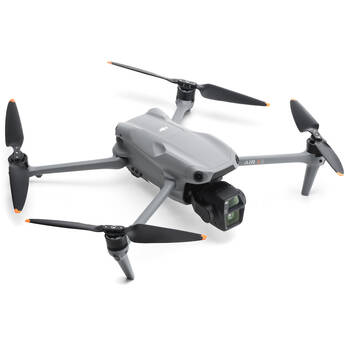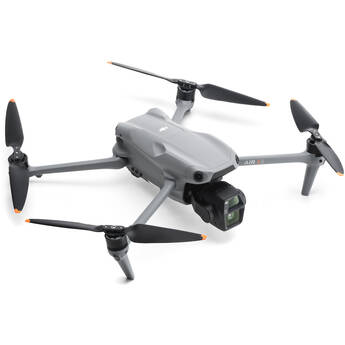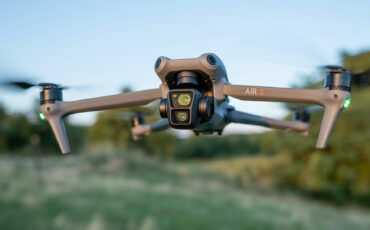THE Allrounder Drone is Here – DJI Air 3S First Look Review
Music Courtesy of Epidemic Sound
The DJI Air 3S was announced recently, and it’s clearly DJI’s new allrounder drone similar to the Air 3, but now boasting a larger 1-inch sensor for its main 24mm camera next to the 70mm telephoto camera, and new front-facing LiDAR for safer flying in low-light environments. These are my first impression DJI Air 3S review after the first couple of flights.
Let me state right at the beginning that this is in no way a fully comprehensive review. It’s a first look the DJI Air 3S which I took to a series of beautiful maiden flights, and my first impressions with the drone, as someone who’s flying various DJI drones multiple times per week (especially the Mavic 3 Pro Cine).
Drone confusion – where does the DJI Air 3S fit into DJI’s lineup?

Before we dive into the specifics of the Air 3S, let’s look at DJI’s lineup of “foldable” drones and how they are positioned with regards to their capabilities, and where the new Air 3S will fit in.
At the bottom end, there’s the still-new DJI Neo which is clearly an entry-level drone that delivers “okay” quality video for amateurs and can be flown in lots of places due to its ultra-low weight of 135 grams. Next is the DJI Mini 3 which shoots better video and photos and can also be flown in many places without permissions because it weighs only 249 grams. However, I think the Mini 3 might be discontinued eventually as we actually have a DJI Mini 4 Pro, but no normal Mini 4 drone. I guess the Neo is taking that entry-level spot now, and the weight and size differences between the Mini 4 Pro and the Neo actually give them a better separation in the market between the two entry-level drones than the Mini 3 and Mini 3 Pro had before.
Philip Bloom's Cinematic Masterclass
Confused? Me too. But wait, I am only getting started …
DJI Air 3 vs. Air 3S vs. Mavic 3 Pro
In the middle of DJI’s lineup of foldable drones, up until now, there’s the DJI Air 3 sitting right above the Mini 4 Pro. In case you missed the great review of the Air 3 by my colleague Jakub, check it our here.

The Air 3 has the beautiful 70mm telephoto camera as the second option, but what’s funny is that main 24mm camera is the same 1-over-1.3 inch CMOS camera that we have in the Mini 4 Pro. And I guess it didn’t sit well with DJI and many of their users, that essentially all of their drones except the high-end Mavic 3 Pro uses the same main camera. The gap between that tiny sensor to the exceptionally good 4/3 CMOS Hasselblad camera that is the main camera in the Mavic 3 Pro, which has been my main drone since it was released, was just too big. In comes the 1-inch sensor for the main camera of the new Air 3S, which offers considerably better low-light capabilities and overall image quality and rendition.
Image quality delivered by DJI Air 3S cameras
Video from both cameras look exceptional, and it’s great that 10-bit D-Log M and full manual camera controls are available on both cameras. While I didn’t have a chance yet to really test the low-light capabilities of the Air 3S, it’s clear that it will be a lot better in this regard than its sibling, the Air 3, with its much smaller sensor. The new 1-inch sensor offers 50 megapixels in photo mode and up to 4K with 60 frames per second in HDR and 4K 120 for high-speed recordings.

New LiDAR enables better low-light flying and obstacle-sensing technology
A first in a DJI drone is the forward-facing LiDAR sensor in addition to camera sensors around the drone and the downward-facing infrared sensors. With the LiDAR, the drone is less dependent on good ambient light to manoeuvre around obstacles, it now can also do this in low light and near darkness.
This better obstacle-sensing technology also enables a “Smart” return-to-home feature that actually avoids obstacles and shows you the return path while the drone lands itself.


Built-in storage, H.265 compression
When taking off for my maiden flight with the drone, I didn’t even bother putting a micro SD card inside because the Air 3S now comes with 42 GB of built-in storage, which gave me about 1 hour and 20 minutes of recording time in H.265 4K at 25 frames per second. And now you don’t even have to power the drone up anymore when connecting it to a computer, the internal drone storage will show up as an external drive.
Talking about codecs, the DJI Air records in the very efficient H.265 codec at a maximum of 130 MBps, and the maximum resolution is 4K. I’ve gotten spoilt recording ProRes in the Mavic 3 Pro Cine, which comes with a built-in 1TB SSD, but I have to say that the H.265 out of the Air 3S is beautiful too and absolutely broadcast-ready. I’ve yet to test how the compression holds up in low light environments but I have a feeling that H.265 is doing a lot better here than much older drones that were only recording the less efficient H.264 at a similar bitrate.
DJI Air 3S review conclusion – a more affordable allrounder drone
To conclude this first-look review of the DJI Air 3S, I have to point out that this drone will definitely serve you well if you want to produce professional-grade video images with a drone even in low-light situations, but don’t need all the bells and whistles of the high-end Mavic 3 Pro.
DJI Air 3S falls in C1 category / A1 subcategory
One very important thing you need to consider is the fact that in Europe, the Air 3S with its 724 grams falls in the C1 category and the A1 subcategory which is much less restrictive than the C2 category of drones. The Mavic 3 Pro is a C2 category drone because it weighs more than 900 grams, and that means a considerable amount of regulations need to be followed and more permissions need to be obtained you want to fly that drone in a lot of spaces. Apart from a comparatively low price of just around 1100 Euros or dollars, this for me is the main reason why the Air 3S with its 1-inch sensor and low-light shooting and flying capabilities will definitely find its market even among professional video shooters and filmmakers.

What do you think about DJI’s newest addition to their drone lineup? Are you looking to upgrade from an older model, or finally get into the drone game? Let us know in the comments below.






























